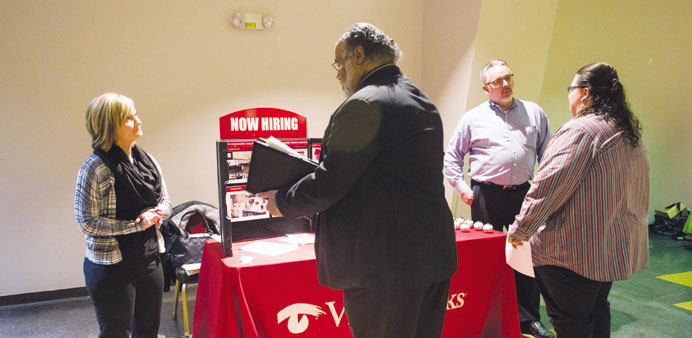Job seekers meet recruiters at the Columbus Career Fair in Ohio. New applications for unemployment benefits held near their pre-recession levels last week and factory activity in the Mid-Atlantic region accelerated in April, painting a bright picture of the US economy.
Reuters/Washington
New applications for unemployment benefits held near their pre-recession levels last week and factory activity in the Mid-Atlantic region accelerated in April, painting a bright picture of the economy.
The economy is regaining its footing after a brutally cold winter and is back on track for faster growth later this year.
“The data add further evidence to the notion that the economy has exerted positive momentum at the start of the second quarter,” said Sam Bullard, a senior economist at Wells Fargo Securities in Charlotte, North Carolina.
Initial claims for state unemployment benefits ticked up 2,000 to a seasonally adjusted 304,000 for the week ended April 12, the Labour Department said yesterday, but stayed close to a 6-1/2 year low touched the prior week.
Economists had forecast first-time applications for jobless benefits rising to 315,000. The four-week moving average for new claims, which irons out week-to-week volatility, hit its lowest level since October 2007.
In a separate report, the Philadelphia Federal Reserve Bank said its business activity index increased to 16.6 this month from 9.0 in March. April’s reading was the highest in seven months and beat economists’ forecasts for only a rise to 10.0.
A reading above zero indicates expansion in the region’s manufacturing, which covers eastern Pennsylvania, southern New Jersey and Delaware. There was a surge in new orders and shipments. Factory employment also increased and workers put in more hours than they did in March.
US stocks were little changed as underwhelming results from tech giants Google and IBM offset the fairly upbeat economic reports. Prices for US Treasury debt fell and the dollar slipped against a basket of currencies.
The reports were the latest in a series to suggest an upswing in the economy. Retail sales and industrial production were robust in March. Employment has picked up since wobbling in December and there is some inflation in the economy.
The harsh winter, combined with weak exports and stock accumulation by businesses, is expected to have cut gross domestic product to an annual growth pace of around 1.5% in the first quarter after a 2.6% rate in the October-December period.
But the economy is expected to snap back in the second quarter as the drag from the weather and inventories fades. Second-quarter GDP growth estimates range as high as a 3.6% pace.
Federal Reserve Chair Janet Yellen said on Wednesday the economy was making “very meaningful progress”, adding it was “quite plausible” it would be back to near full employment by the end of 2016.
Some economists argue that the recent raft of upbeat data, especially labor market indicators, suggests there might not be a lot of slack in the economy, as policymakers believe.
“The jobless claims data also suggest the labor market may be making progress toward the Fed’s labor market objective more quickly than many policymakers expect,” said John Ryding, chief economist at RDQ Economics in New York.
The claims data covered the survey week for April nonfarm payrolls. Despite last week’s increase, claims were down 19,000 between the March and April survey periods, which suggests an acceleration in job growth.
Job growth averaged about 195,000 per month in February and March, with the unemployment rate holding at near a five-year low of 6.7% over that period.
Labour market indicators such as job openings, the duration of unemployment and short-term unemployment, suggest some tightening in conditions.
The health of the labor market will most likely determine when the US central bank starts raising benchmark interest rates, which it has kept near zero since December 2008.
The Fed is expected to conclude its monthly bond buying programme later this year and most economists expect the first rate hike will be in the second half of 2015.
The claims report showed the number of people still receiving benefits after an initial week of aid dropped 11,000 to 2.74mn in the week ended April 5. That was the lowest level in the so-called continuing claims since December 2007.
“The ongoing improvement in continuing claims remains encouraging amid more positive labor market dynamics, suggesting that workers are not simply leaving the labor force but likely finding gainful employment,” said Gennadiy Goldberg, an economist at TD Securities in New York.



